Are you looking for ways to make science fun and meaningful for your preschoolers? Do you struggle to find hands-on activities that are both educational and easy to set up? Are you concerned about safety, engagement, or whether your preschoolers are really benefiting from science play? If these questions resonate with you, you’re not alone. Many early childhood educators and parents want to include science in their daily routine, but aren’t sure where to start.
Science activities for preschoolers are essential for building foundational skills in observation, problem-solving, and critical thinking—all in a way that’s playful and age-appropriate. These activities aren’t just for fun—they’re a key part of early childhood development. They spark curiosity, encourage hands-on learning, and foster a love of exploration that can last a lifetime.
Science isn’t just a school subject—it’s a way of seeing the world. And the earlier children are exposed to simple experiments and scientific concepts, the more likely they are to grow into confident learners. In this article, I’ll share 61 fun and easy science activities designed specifically for preschoolers. These activities cover all four seasons, major holidays, and favorite preschool themes. They’re simple to prepare, use affordable materials, and most importantly, they’re a hit with kids.
How Science Activities Support Early Childhood Development
Cognitive Growth Through Science Play
Science activities for preschoolers foster cognitive development by engaging children in making observations, testing predictions, and identifying patterns. Whether watching ice melt or creating a vinegar-and-baking-soda reaction, young children learn to think critically and develop an understanding of cause and effect.
Language and Communication Skills
Science activities for preschoolers also enrich vocabulary and communication. Describing textures, comparing sizes, and narrating results all help children express ideas more clearly. These interactions promote storytelling, questioning, and descriptive language—vital for literacy development.
Physical and Motor Skills Enhancement
Pouring water, scooping seeds, and sorting materials during science activities for preschoolers strengthen fine motor skills and hand-eye coordination. These small actions prepare preschoolers for writing, cutting, and other school tasks that require manual dexterity.
Social Development and Teamwork
When preschoolers engage in group science activities, they practice sharing, taking turns, and listening to peers. Collaborative experiments build empathy and social competence—important life skills fostered through the process of discovery.
Long-Term Learning Confidence
By doing science activities for preschoolers early on, children become comfortable with scientific thinking. This boosts their confidence in STEM subjects as they grow older, helping them feel capable of solving problems and making sense of the world around them.
What Makes a Good Science Activity for Preschoolers?
Not all activities are created equal—especially when it comes to science activities for preschoolers. The best ones share a few important qualities that make them both effective and engaging for young learners. To ensure your preschool science activities are developmentally appropriate and exciting, consider the following principles:
Simplicity and Accessibility
Great science activities for preschoolers are easy to set up and use materials commonly found at home or in classrooms. Simplicity allows children to focus on the science itself, rather than being distracted by complex tools or instructions.
Hands-On and Interactive
Preschoolers learn best by doing. Activities that involve pouring, mixing, shaking, observing, and measuring help young children actively engage with scientific concepts. Hands-on exploration fuels better retention and deeper understanding.
Safe and Age-Appropriate
Safety is paramount. Choose science activities for preschoolers that are non-toxic, free of choking hazards, and require minimal adult supervision. Always consider allergies and sensitivities when selecting materials.
Spark Curiosity and Encourage Questions
The best activities naturally inspire questions. Why did that happen? What if I try this? When preschoolers are encouraged to wonder and experiment, they’re doing real science. These moments of curiosity are when learning truly sticks.
Visual and Sensory Appeal
Colorful reactions, interesting textures, fun sounds—all of these captivate preschoolers. Choose science activities that appeal to multiple senses to keep children engaged and excited to participate.
Science activities for preschoolers should be fun, engaging, and educational. When they hit all these marks, they not only teach science concepts—they also lay the foundation for a lifelong love of learning.
61 Fun & Easy Science Activities for Preschoolers
🌸 Spring Science Activities for Preschoolers
Spring is a season of growth, renewal, and discovery—perfect for engaging preschoolers in science activities. During spring, children can observe changes in the environment, explore plant life, and experience weather transitions. These spring-themed science activities for preschoolers combine natural curiosity with hands-on learning, helping young minds make sense of the world blooming around them.
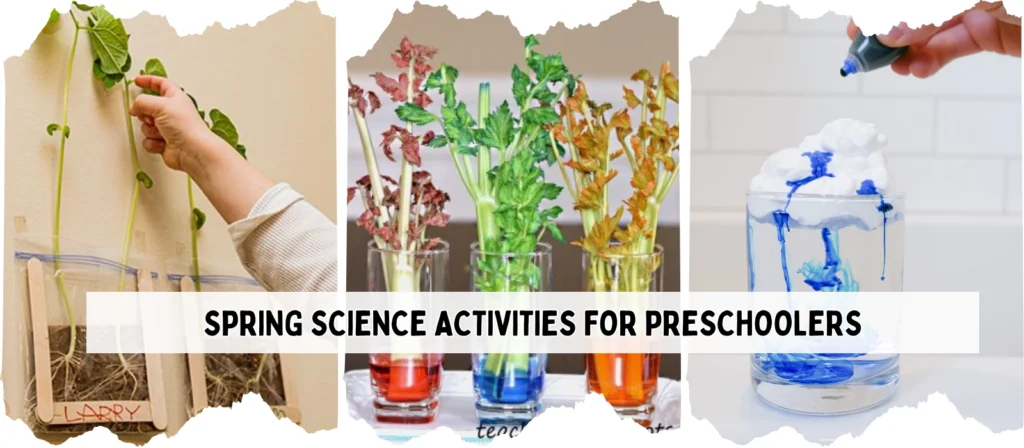
1. Seed Germination in a Bag
This classic science activity for preschoolers allows children to witness how seeds sprout roots and shoots without soil. It’s an excellent introduction to plant biology and growth cycles.
Materials: Ziplock bag, paper towel, water, bean seeds
Steps: Wet the paper towel and fold it to fit inside the bag. Insert a few bean seeds between the towel and the bag wall. Seal and tape the bag to a sunny window. Observe changes daily.
2. Rainbow Celery Experiment
This visually exciting experiment shows how plants absorb water, helping preschoolers understand how nutrients travel through stems.
Materials: Celery stalks with leaves, cups, water, food coloring
Steps: Fill cups with water and add different colors. Place a celery stalk in each. Watch how water travels up and changes the celery’s color.
3. Rain Cloud in a Jar
A perfect way to explain weather patterns to preschoolers, this experiment visually mimics how rain falls from clouds.
Materials: Clear jar, shaving cream, water, food coloring, dropper
Steps: Fill the jar with water, add a shaving cream layer. Drop colored water onto the cream and watch it fall like rain into the jar.
4. Nature Walk Collection and Classification
This exploratory activity encourages preschoolers to observe and categorize items from nature, building scientific thinking and classification skills.
Materials: Bags/baskets, magnifying glasses, labels
Steps: Go for a walk, collect small natural items. Back inside, classify them by color, size, shape, or texture.
5. Plant Parts Sorting Station
Help children explore the anatomy of plants by breaking them down into parts—root, stem, leaves, flower—for hands-on learning and sensory exploration.
Materials: Real plants, scissors, trays, magnifiers
Steps: Cut apart plants into roots, stems, leaves, flowers. Let children explore and sort each part.
🌞 Summer Science Activities for Preschoolers
Summer offers endless opportunities for fun, sun, and scientific discovery. From exploring heat and water to observing light and insects, these summer science activities for preschoolers turn everyday play into exciting experiments.
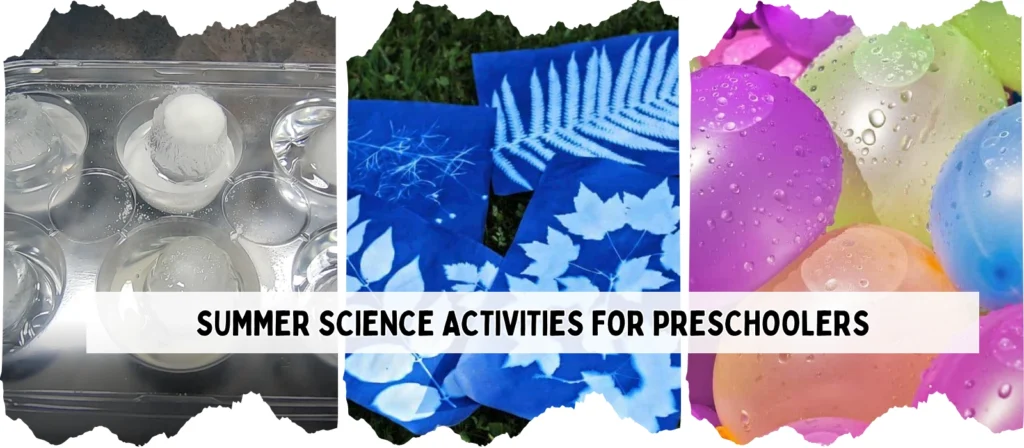
6. Melting Ice Race
This activity helps preschoolers understand how temperature affects matter by racing to melt ice cubes using various methods.
Materials: Ice cubes, metal spoons, salt, warm water, timer
Steps: Give each child an ice cube and different tools. Ask which one melts fastest and why. Compare results to introduce heat and melting.
7. DIY Sun Prints
Using the power of the sun, children can create artwork and learn about UV exposure and shadow formation.
Materials: Dark construction paper, flat objects (leaves, keys), sunny space
Steps: Arrange objects on paper and place in sunlight. After a few hours, remove objects and see the faded print left behind.
8. Water Balloon Science Smash
This is a high-energy science activity that teaches about water pressure and motion while keeping kids cool.
Materials: Water balloons, chalk, blacktop or grass, tape measure
Steps: Drop or toss balloons from different heights. Measure splash radius. Compare sizes and heights for cause-effect learning.
9. Sink or Float Pool Test
Perfect for poolside or water bin fun, this classic science activity lets kids explore density and buoyancy.
Materials: Assorted small items (spoon, sponge, crayon), water tub
Steps: Let children predict and test whether each item sinks or floats. Discuss why results differ.
10. Evaporation Station
Teach about the water cycle and evaporation through simple, sunny-day observation.
Materials: Clear cups, water, marker, sunny windowsill
Steps: Fill cups with water, mark the water line, and check over time to see evaporation in action.
🍂 Fall Science Activities for Preschoolers
Autumn offers rich sensory experiences, from falling leaves to cooler temperatures. These fall science activities for preschoolers tap into seasonal changes to teach observation, weather, and nature cycles.
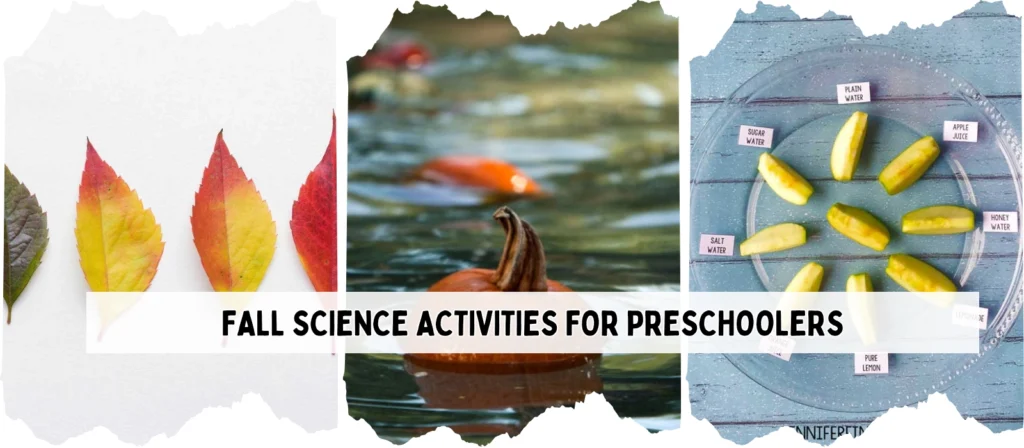
11. Leaf Color Change Investigation
This science activity for preschoolers helps children understand why leaves change color in autumn.
Materials: Leaves, rubbing alcohol, jars, coffee filters, plastic bags
Steps: Crush leaves in jars with alcohol. Let sit in bags overnight. Use filters to separate colors and observe pigment breakdown.
12. Pumpkin Sink or Float
Introduce buoyancy using a seasonal favorite—pumpkins!
Materials: Small pumpkins, large clear tub of water
Steps: Ask children to guess if pumpkins float. Place in water and observe. Try different pumpkin sizes to compare.
13. Apple Oxidation Observation
This simple experiment shows how apples react to air.
Materials: Apple slices, lemon juice, water, timer, plates
Steps: Coat slices in different liquids. Leave exposed to air. Observe browning at intervals to learn about oxidation.
❄️ Winter Science Activities for Preschoolers
Cold weather doesn’t stop learning—it enhances it! These winter science activities for preschoolers use ice, snow, and seasonal concepts to fuel scientific discovery.
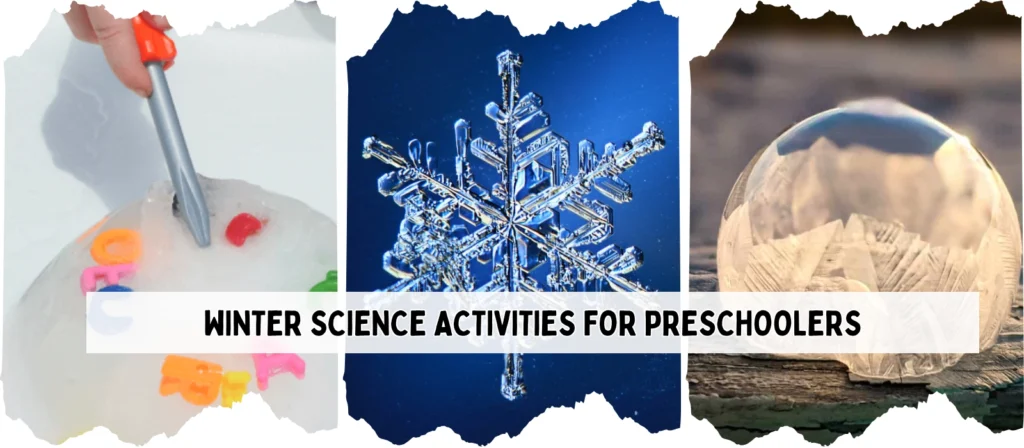
14. Ice Excavation Dig
Freeze small toys in ice and let preschoolers free them—like little archaeologists!
Materials: Containers, water, plastic toys, salt, droppers
Steps: Freeze toys in water overnight. Use salt and warm water to melt and retrieve.
15. Snowflake Symmetry
Teach symmetry and crystal shapes using snowflakes.
Materials: Paper, scissors, markers
Steps: Fold paper and cut snowflake shapes. Unfold to reveal symmetry. Use markers to color halves identically.
16. Frozen Bubble Science
A magical winter experiment perfect for sub-freezing days.
Materials: Bubble solution, straw or wand, freezer (or outdoors)
Steps: Blow bubbles onto a tray in the cold. Watch as they freeze into delicate, frosty domes.
🦃 Thanksgiving Science Activities for Preschoolers
Thanksgiving is a perfect time to combine tradition and science. These Thanksgiving-themed science activities for preschoolers encourage creativity and inquiry.
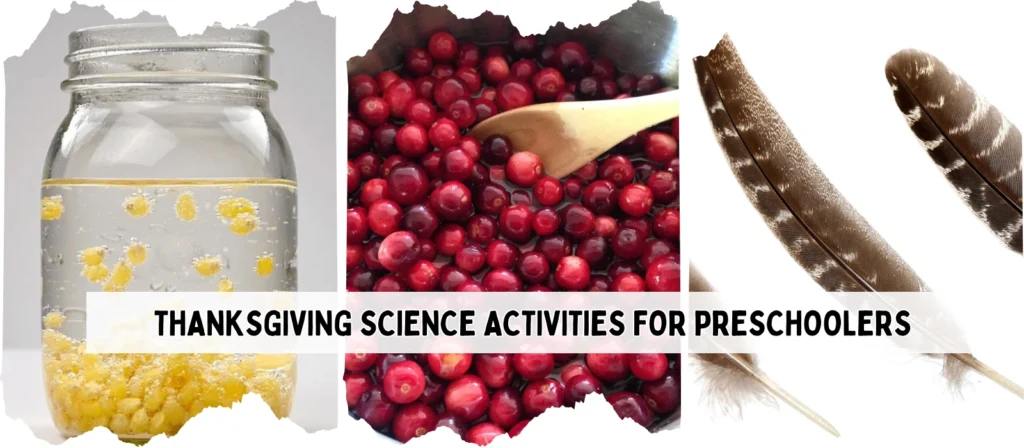
17. Dancing Corn Experiment
A fizzy, fizzy reaction to excite little learners.
Materials: Corn kernels, vinegar, baking soda, clear glass
Steps: Add kernels to a glass of vinegar. Slowly add baking soda. Watch the bubbles lift the corn—then drop it again!
18. Cranberry Science Exploration
Use cranberries to teach about buoyancy and absorption.
Materials: Fresh and dried cranberries, bowls of water
Steps: Place cranberries in water. Observe which sink or float. Compare fresh vs. dried and discuss why.
19. Turkey Feather Static Electricity
Turn a turkey craft into an electrifying experiment.
Materials: Balloons, tissue paper feathers, wool cloth
Steps: Rub balloon with cloth to create static. Hover it over feathers and watch them move.
Cold weather doesn’t stop learning—it enhances it! These winter science activities for preschoolers use ice, snow, and seasonal concepts to fuel scientific discovery.
🎃 Halloween Science Activities for Preschool
Halloween is the perfect time for spooky, silly, and slimy science activities. These Halloween science activities for preschoolers combine fun with educational concepts like reactions, states of matter, and cause and effect.
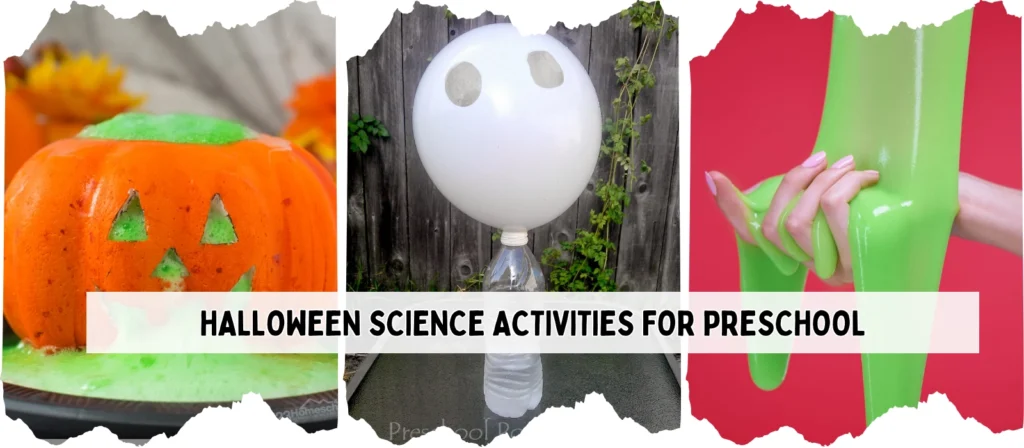
20. Pumpkin Volcanoes
A Halloween twist on the baking soda and vinegar reaction that never fails to delight preschoolers.
Materials: Small pumpkins (carved), baking soda, vinegar, food coloring, dish soap
Steps: Hollow out a small pumpkin. Add baking soda, a squirt of dish soap, and food coloring. Pour in vinegar and watch the eruption.
21. Ghost Balloon Experiment
A simple chemical reaction makes a ghost balloon inflate on its own!
Materials: White balloon with ghost face, vinegar, baking soda, plastic bottle, funnel
Steps: Fill bottle with vinegar. Place baking soda inside balloon using a funnel. Attach balloon to bottle and lift—watch the ghost “rise.”
22. Slime Science
Preschoolers love goo! Teach about polymers with homemade Halloween-themed slime.
Materials: School glue, water, food coloring, liquid starch or borax
Steps: Mix glue and water with color. Slowly add starch/borax while stirring to create slime. Stretch and explore.
🌍 Earth Day Science Activities for Preschoolers
Earth Day is a great opportunity to introduce preschoolers to environmental science. These Earth Day science activities for preschoolers teach kids about conservation, sustainability, and the importance of protecting nature.
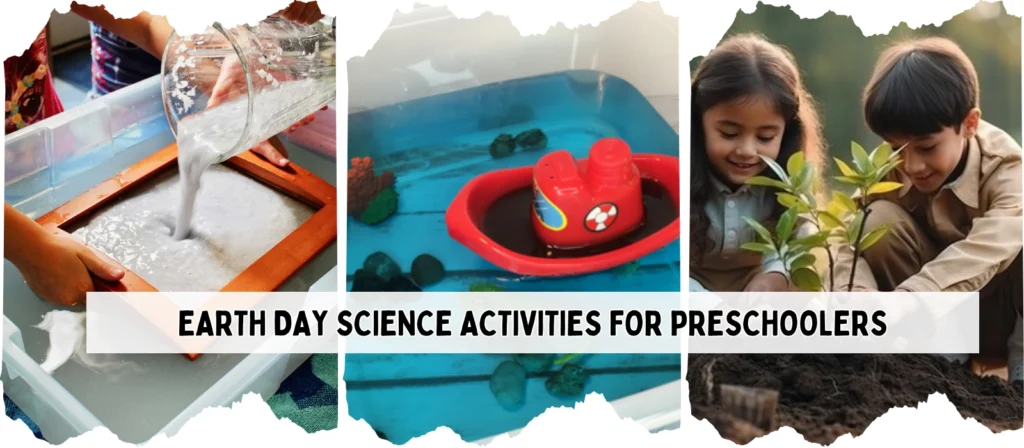
23. Recycled Paper Making
Help children understand recycling through a hands-on process.
Materials: Used paper scraps, blender, water, screen, towel
Steps: Blend paper scraps with water. Pour onto a screen over a towel to drain. Let dry into new paper.
24. Pollution Water Simulation
Show the effects of pollution on clean water in a dramatic, visual way.
Materials: Clear water, cooking oil, dirt, trash bits, cups
Steps: Start with clean water. Add pollutants one at a time. Ask children how we can clean it again—highlight the challenge of pollution.
25. Plant-a-Tree Observation Station
Celebrate nature by planting seeds and tracking growth.
Materials: Small pots, soil, seeds (beans or flowers), water
Steps: Let each child plant and water their seed. Observe daily and journal growth stages.
🎄 Christmas Science Activities for Preschoolers
Christmas brings lights, colors, and excitement—perfect for blending fun with learning. These Christmas science activities for preschoolers explore concepts like absorption, chemical change, and freezing.
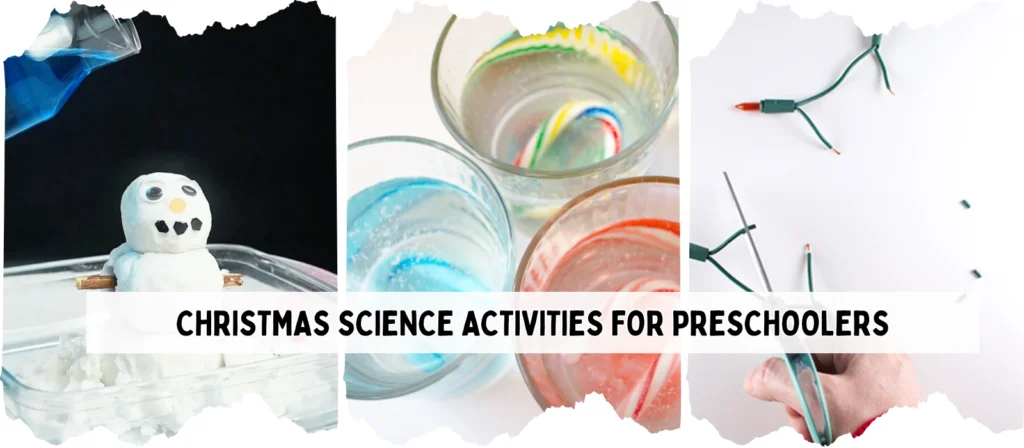
26. Melting Snowman Science
Teach states of matter while watching a snowman melt indoors.
Materials: Baking soda snowman (formed with water), vinegar, dropper
Steps: Create snowman shape using baking soda paste. Drop vinegar and observe it fizz and melt.
27. Candy Cane Color Experiment
Explore how sugar dissolves and colors spread.
Materials: Candy canes, clear cups, water (warm and cold)
Steps: Place candy canes in different temperature water. Observe how color and sugar dissolve over time.
28. Christmas Light Circuit Exploration
Introduce simple circuits using battery-powered Christmas lights.
Materials: Mini LED light string, AA batteries, aluminum foil
Steps: Help kids connect foil to battery and light to make a complete circuit. Light up their curiosity!
🥗 Nutrition Science Activities for Preschoolers
Nutrition science activities for preschoolers teach healthy habits while integrating fun experiments. These activities help kids explore food groups, digestion, and how our bodies use nutrients.
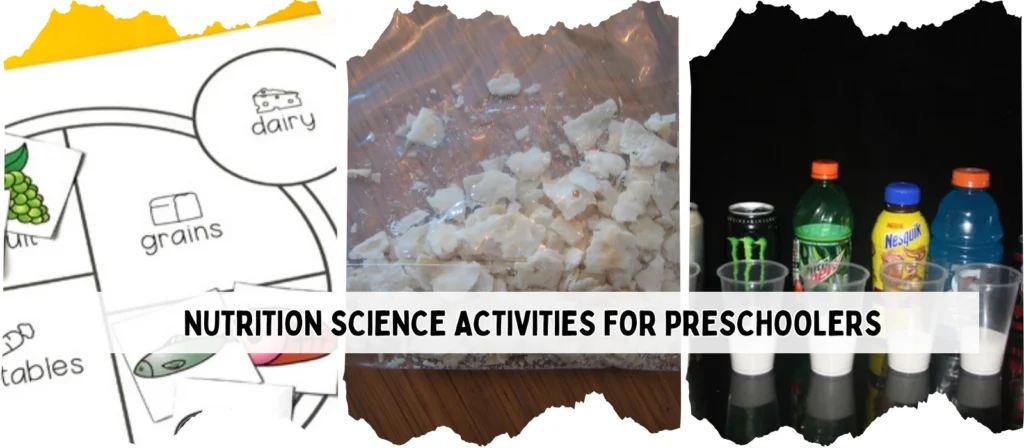
29. Food Group Sorting Challenge
Help kids identify different types of food and their purposes.
Materials: Toy food items or printed pictures, labeled baskets
Steps: Invite children to sort food into categories: fruits, vegetables, grains, protein, dairy. Discuss why each is important.
30. Digestion in a Bag
Simulate the stomach’s job in digesting food.
Materials: Ziplock bag, crackers, banana, orange juice
Steps: Mash crackers and banana in bag. Add orange juice to mimic stomach acid. Watch how food breaks down.
31. Sugar Detectives
Learn which foods have hidden sugars.
Materials: Sugar cubes, spoons, labels from food packages
Steps: Compare the amount of sugar in drinks/snacks. Use sugar cubes to show quantities. Discuss healthier alternatives.
🧠 Science and Sensory Activities for Preschoolers
Sensory science activities for preschoolers help them engage their five senses while learning fundamental scientific concepts. These are ideal for tactile and kinesthetic learners.
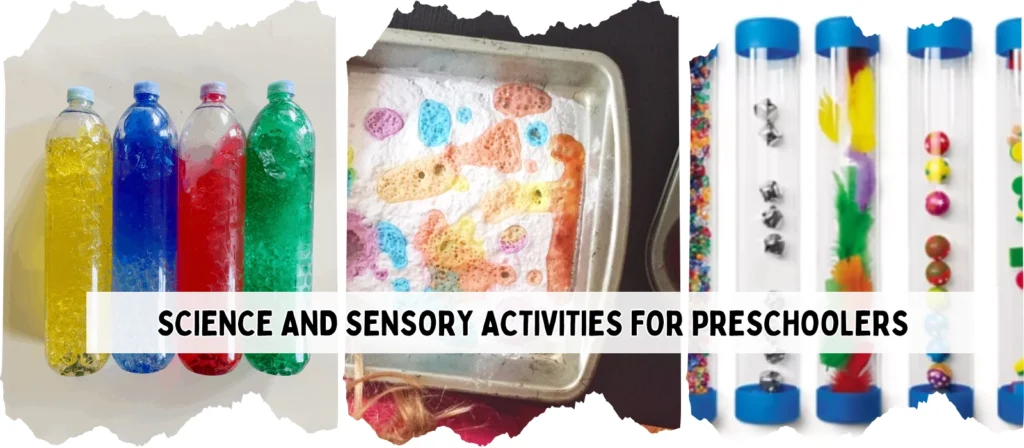
32. Rainbow Sensory Bottles
Colorful bottles filled with different materials for visual and tactile exploration.
Materials: Clear bottles, baby oil, glitter, water beads, food coloring
Steps: Fill each bottle with unique sensory content. Let kids shake and observe textures and colors.
33. Fizzy Color Mixing Tray
Encourage children to explore color blending and chemical reactions.
Materials: Baking soda, vinegar, food coloring, tray, droppers
Steps: Place baking soda in tray. Add colored vinegar with droppers. Watch colors mix and fizz.
34. Sound Tube Exploration
Stimulate auditory learning with DIY sound makers.
Materials: Paper towel tubes, rice, beans, bells, tape
Steps: Fill tubes with different items. Seal and let children shake and identify sounds.
🔢 Math and Science Activities for Preschoolers
Combining math with science strengthens problem-solving and critical thinking. These math and science activities for preschoolers highlight measurement, counting, and comparison.
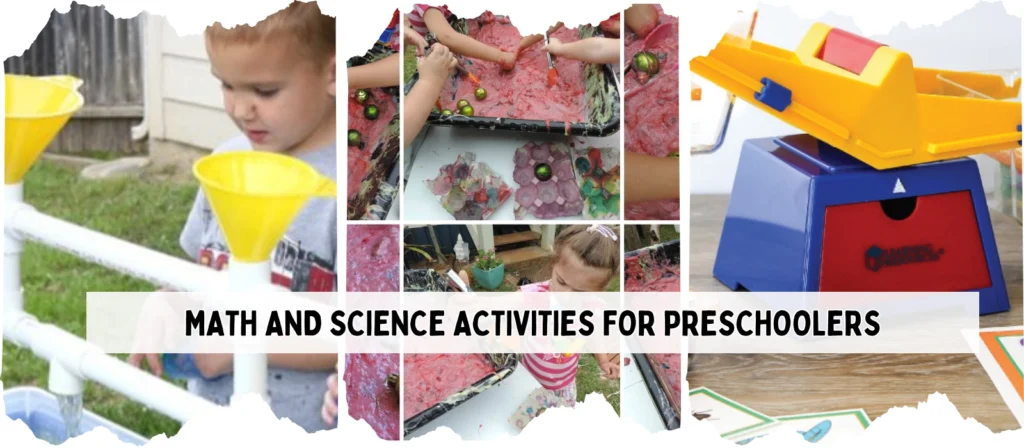
35. Measuring Water Station
Teach volume and units through fun water play.
Materials: Measuring cups, water, tubs
Steps: Let kids fill, pour, and compare water amounts. Introduce terms like full, half, more, and less.
36. Pattern Blocks in Slime
Explore patterns and shapes while engaging fine motor skills.
Materials: Slime, plastic pattern blocks
Steps: Place blocks in slime. Let kids pull out and arrange them into patterns or shapes.
37. Weight and Balance Test
Introduce basic physics and comparison.
Materials: Toy balance scale, blocks, natural items
Steps: Compare weights of various items. Let children guess and test which are heavier or lighter.
🌊 Ocean Activities for Preschoolers in Science
Ocean-themed science activities for preschoolers introduce children to marine life, water properties, and the wonders of the sea. These sensory-rich experiments are perfect for summer or water week themes.
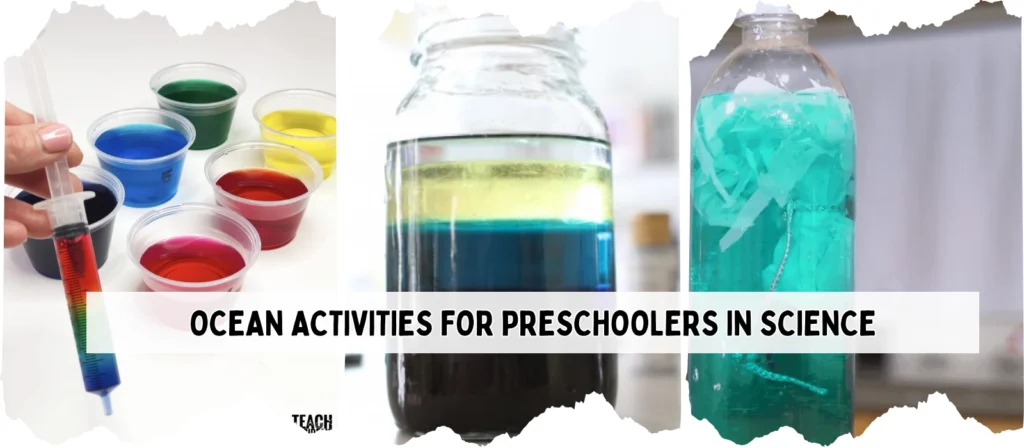
38. Saltwater Density Test
Explore how salt changes water’s density.
Materials: 2 clear cups, water, salt, egg
Steps: Fill both cups with water. Add lots of salt to one. Drop an egg into both and compare which floats.
39. Ocean Layers Jar
Teach ocean layers through density and color.
Materials: Honey, dish soap, colored water, oil, tall jar
Steps: Layer each liquid slowly in a jar. Watch them separate and mimic ocean zones.
40. Jellyfish in a Bottle
A fun craft that introduces ocean animals.
Materials: Clear bottle, water, plastic bag, food coloring
Steps: Make a jellyfish shape from a bag. Fill with water, insert into bottle with blue-tinted water. Seal and observe movement.
🐞 Bug Science Activities for Preschoolers
Bug science activities for preschoolers ignite interest in entomology while promoting observation and classification. These insect-themed lessons are perfect for spring or nature units.
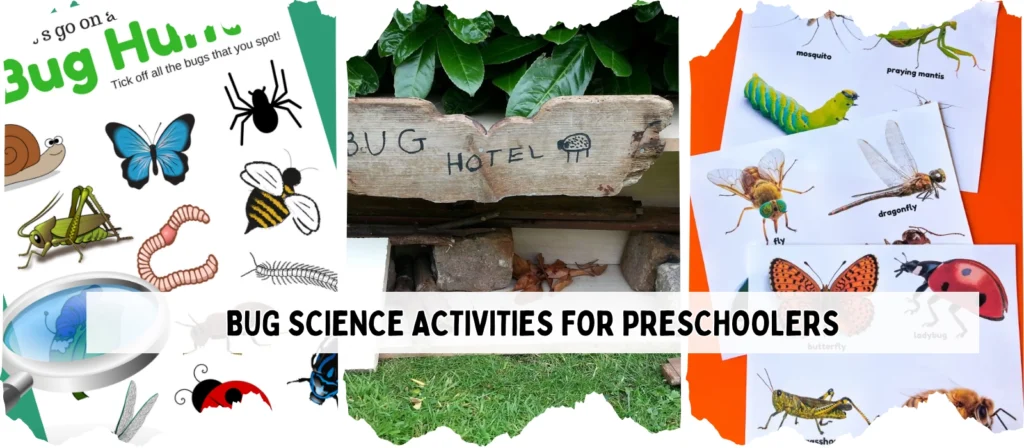
41. Bug Hunt and Chart
Track bugs found outdoors using tally marks or photos.
Materials: Bug catchers, magnifying glass, paper, pencil
Steps: Go on a bug hunt. Record findings by drawing or checking a list. Identify common backyard insects.
42. Build a Bug Hotel
Create a shelter for bugs while learning about habitats.
Materials: Toilet rolls, sticks, leaves, small box
Steps: Fill box or tube with natural materials. Place outdoors and check daily to see which bugs move in.
43. Bug Sorting by Legs/Wings
Classify bugs based on body parts.
Materials: Bug toys or printables, sorting trays
Steps: Let kids group bugs with wings, 6 legs, or no wings. Discuss each feature and why it matters.
🐜 Insect Science Activities for Preschoolers
Insect science activities for preschoolers take a closer look at the creatures that crawl, fly, and buzz. These activities build vocabulary and curiosity about the smallest animals around us.
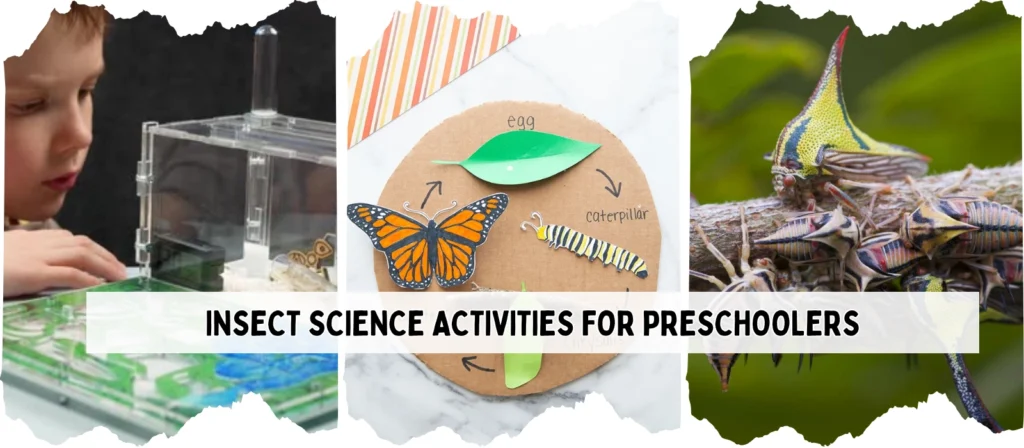
44. Ant Farm Observation
Kids learn about teamwork and tunnels.
Materials: Clear container, sand or soil, live ants (store-bought), food crumbs
Steps: Create ant farm with layers of soil. Add ants and observe their movement and tunnels over days.
45. Butterfly Life Cycle Craft
Reinforce metamorphosis with a creative project.
Materials: Paper plate, colored paper, glue, scissors
Steps: Divide plate into sections: egg, larva, pupa, butterfly. Craft each stage with materials and label.
46. Insect Camouflage Search
Learn about survival through disguise.
Materials: Printed insect photos, leaves, fabric scraps
Steps: Hide insect images among matching backgrounds. Ask kids to find them and discuss how camouflage helps.
🧍 All About Me Science Activities for Preschoolers
“All About Me” science activities for preschoolers promote self-awareness, biology, and personal discovery. They help kids learn about the human body, senses, and emotions in fun and relatable ways.
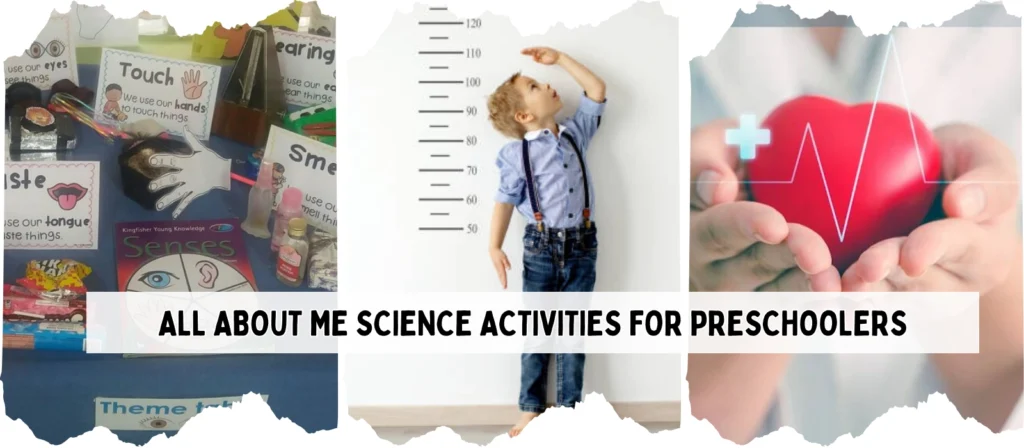
47. My Senses Exploration Table
Encourage kids to discover how we experience the world using sight, smell, touch, taste, and sound.
Materials: Scent jars, textured items, taste-safe samples, headphones
Steps: Set up a station for each sense. Let children explore each one and describe what they experience.
48. Measuring My Height
Introduce basic measuring tools and math comparisons.
Materials: Measuring tape, paper chart, markers
Steps: Have each child stand next to a chart. Mark their height and compare with peers. Discuss growth over time.
49. Heartbeat Investigation
Introduce the circulatory system with movement.
Materials: Stopwatch, soft ball, yoga mat
Steps: Measure resting heart rate. Do jumping jacks, then measure again. Discuss how the heart helps our body.
🦕 Dinosaur Science Activities for Preschoolers
Dinosaurs captivate preschoolers’ imaginations and provide a thrilling path into science. These dinosaur science activities for preschoolers teach about fossils, timelines, and prehistoric life.
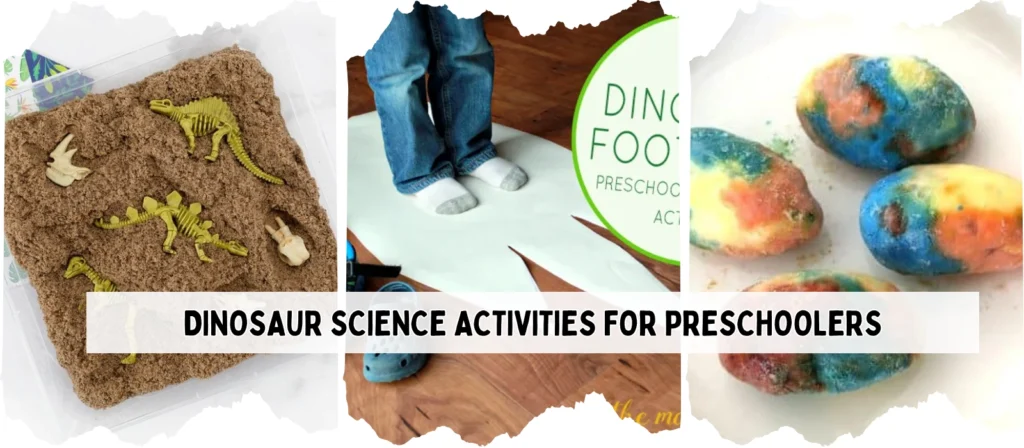
50. DIY Fossil Dig
Create an excavation experience indoors.
Materials: Kinetic sand, small dinosaur bones or toys, paintbrushes
Steps: Bury items in sand. Let kids excavate and brush them off gently, just like paleontologists.
51. Dino Footprint Measurement
Compare dinosaur sizes to human sizes.
Materials: Dino footprint cutouts, tape measure, string
Steps: Tape footprints on floor. Let kids measure and walk beside them. Discuss sizes and species.
52. Baking Soda Dinosaur Eggs
Combine science and sensory play with erupting dino eggs.
Materials: Baking soda, water, food coloring, small dino toys, vinegar
Steps: Make a thick paste and mold around toys. Freeze overnight. Use vinegar to “hatch” them.
🚜 Farm Science Activities for Preschoolers
Farm-themed science activities for preschoolers help them understand where food comes from and explore animals, plants, and machines. These hands-on projects are perfect for spring or rural units.
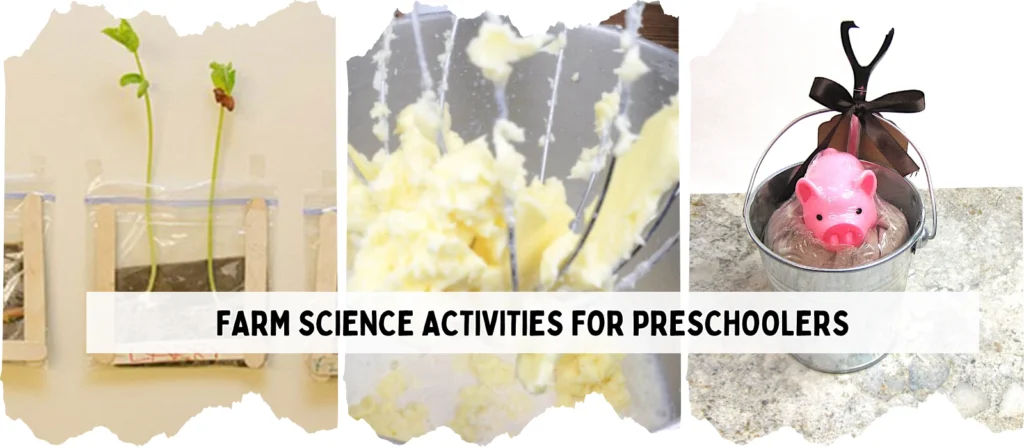
53. Growing Beans in a Bag
See how seeds sprout before planting.
Materials: Ziplock bag, paper towel, bean seed, water, tape
Steps: Wet towel, insert seed and place in bag. Tape to sunny window and observe daily.
54. Cow’s Milk to Butter
Teach physical change with cream turning into butter.
Materials: Heavy cream, small jar with lid, optional salt
Steps: Pour cream in jar and shake. After 5–10 minutes, observe separation. Taste the fresh butter.
55. Muddy Pig Science Bath
Explore cleaning and textures with a farm twist.
Materials: Toy pigs, chocolate pudding, water, brushes
Steps: Cover pigs in pudding “mud.” Let kids clean them using brushes and water.
💧 Water Science Activities for Preschoolers
Water science activities for preschoolers are naturally engaging and sensory-rich. These experiments explore properties of water, including temperature, states, movement, and more—all while having fun.
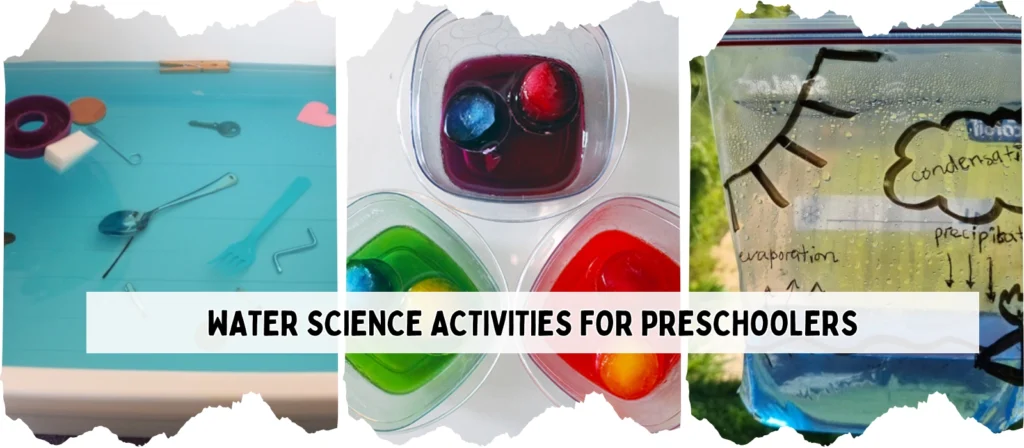
56. Sink or Float Discovery
Classic and always fun, this activity teaches about density and materials.
Materials: Tub of water, assorted small objects (spoon, sponge, toy, rock)
Steps: Let kids predict if each item will sink or float. Place in water and compare results.
57. Ice Cube Color Race
Learn how heat and color interact.
Materials: Ice cubes with food coloring, white tray, stopwatch
Steps: Place colored cubes on tray in sunlight. Observe melting speed and how colors blend.
58. Water Cycle in a Bag
Visualize evaporation, condensation, and precipitation.
Materials: Ziplock bag, water, blue food coloring, marker, tape
Steps: Draw cloud/sun/water line on bag. Fill partially with blue water. Tape to window and watch cycle form.
🍎 Apple Science Activities for Preschoolers
Apple science activities for preschoolers are ideal for fall and harvest themes. They combine sensory play, chemistry, and biology in deliciously fun ways.
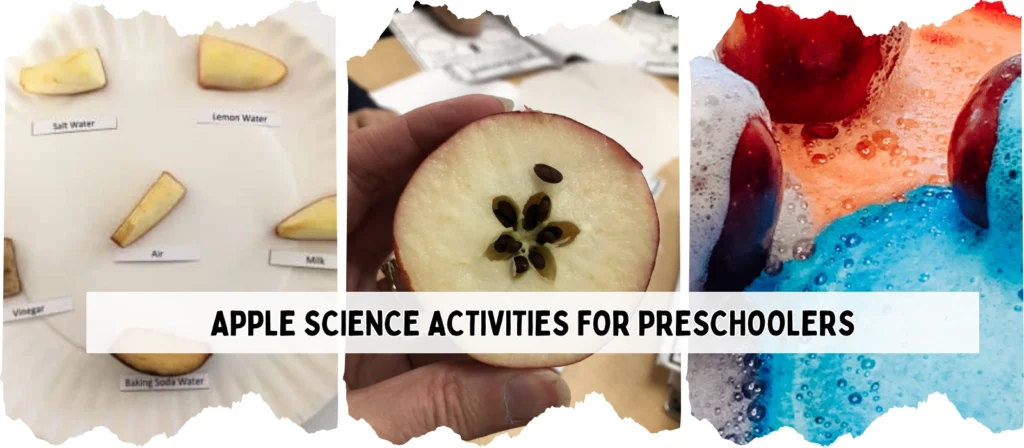
59. Apple Oxidation Test
See how air changes fruit color.
Materials: Apple slices, lemon juice, salt water, plain water, timer
Steps: Dip slices in different liquids. Leave out and observe browning speed.
60. Apple Seed Exploration
Introduce plant anatomy and counting.
Materials: Apples, magnifying glass, tweezers, paper
Steps: Cut apples, remove seeds, count and observe. Compare seed numbers and discuss growth.
61. Apple Eruption Experiment
Turn apples into mini volcanoes!
Materials: Cored apples, baking soda, vinegar, food coloring, tray
Steps: Place soda and coloring inside apple. Pour vinegar to erupt.
Safety Tips for Preschool Science Experiments
Creating a safe and supportive environment is critical when doing science activities for preschoolers. These safety guidelines ensure children explore freely without unnecessary risk.
Supervise All Activities Closely
Young children should never handle chemicals, heat, or glass without adult supervision. Always remain present and guide them during each experiment. Assign specific adults to small groups if the activity involves any reactive materials. Provide clear, step-by-step instructions before beginning, and repeat them with visual aids or modeling to reinforce understanding.
Choose Non-Toxic, Age-Appropriate Materials
Only use edible or safe household items like vinegar, baking soda, food coloring, or gelatin for preschool science experiments. Avoid small objects that can be swallowed, sharp tools, or anything labeled as hazardous. Always read labels carefully and opt for washable, hypoallergenic materials whenever possible.
Be Aware of Allergies and Sensitivities
Before conducting activities, check for food allergies (e.g., dairy, nuts, gluten) or skin sensitivities that could arise from ingredients like citrus or essential oils. Maintain an allergy chart visible to all staff. If you’re using unusual materials, do a quick skin patch test beforehand. Inform caregivers about the planned experiment so they can raise concerns.
Teach Clean-Up Procedures
Include children in the cleanup routine to build responsibility and safety habits. Teach them how to wipe down tables, rinse tools, and sort materials for reuse or recycling. Use color-coded bins for easy cleanup and store kid-safe cleaning supplies in an accessible location with clear instructions.
Dispose of Materials Responsibly
Solid waste such as used paper towels, baking soda residue, or plant matter should go into a compost or trash bin, depending on local guidelines. Liquids like vinegar or soapy water can usually be poured down the drain, but avoid disposing of oils or thick mixtures that can clog pipes. Clean and dry tools before storing to prevent mold and damage.
How to Set Up a Preschool Science Learning Area?
A dedicated science area encourages daily exploration and inquiry. Here’s how to set up an inviting and functional science learning space in your preschool.
Prioritize Light, Air, and Accessibility
Choose a space near a window for natural lighting, which helps children see colors and details clearly. Ensure proper ventilation, especially when using water or sensory materials. Keep the space open enough for small groups to gather without feeling crowded, and make sure every item is within children’s reach to foster independence.
Organize with Open Shelving and Labeling
Use transparent or clearly labeled bins to categorize tools: magnifiers, test tubes, measuring cups, nature items, etc. Color-coded labels with images help non-readers identify items easily. Display only a few tools at a time to avoid clutter and rotate materials weekly to maintain interest.
Include Furniture that Supports Exploration
Use child-sized tables, stools, and storage units. Consider adjustable-height tables for experiments that involve pouring or mixing. Products from XIHA Furniture offer ergonomic, durable, and easy-to-clean furnishings designed for preschoolers. Their rounded edges and soft corners reduce injury risk while still offering maximum usability.
Add an Observation and Discovery Corner
Dedicate a quiet section for children to study rotating items like pinecones, feathers, insects in jars, or simple machines. Use display trays, magnifying stands, and mini light tables to enhance visibility. Provide simple record sheets or science journals for kids to draw or write their observations.
Encourage Autonomy and Curiosity
Keep experiment cards or picture instructions nearby so children can conduct simple science activities on their own. Add questions on the wall like “What do you notice?” or “What do you think will happen next?” Offer lab coats or goggles as role-play items to make them feel like real scientists and boost engagement.
A thoughtfully designed science corner helps foster independence and excitement around daily scientific discovery.
Conclusion
Science activities for preschoolers do more than fill time—they awaken curiosity, reinforce important developmental skills, and cultivate a mindset of exploration. Through hands-on experimentation, children begin to understand the world around them, test ideas, and learn to think critically from a very young age.
Creating a safe, well-equipped space for these discoveries is just as important as the experiments themselves. From organizing child-friendly materials to modeling cleanup routines, thoughtful planning ensures that preschool science is both fun and responsible. Safety and structure give children the freedom to explore confidently.
At XIHA Furniture, we believe that every learning corner should inspire wonder. Our specially designed furniture supports young learners with comfort, durability, and function. Whether you’re building your first preschool science area or upgrading your space, we’re here to help turn learning into an adventure—one experiment at a time.



